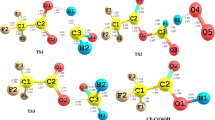Abstract
Theoretical investigations are carried out on reaction mechanism of the reactions of CF3CH2NH2 (TFEA) with the OH radical by means of ab initio and DFT methods. The electronic structure information on the potential energy surface for each reaction is obtained at MPWB1K/6-31+G(d,p) level and energetic information is further refined by calculating the energy of the species with a Gaussian-2 method, G2(MP2). The existence of transition states on the corresponding potential energy surface is ascertained by performing intrinsic reaction coordinate (IRC) calculation. Our calculation indicates that the H abstraction from –NH2 group is the dominant reaction channel because of lower energy barrier. The rate constants of the reaction calculated using canonical transition state theory (CTST) utilizing the ab initio data. The agreement between the theoretical and experimental rate constants is good at the measured temperature. From the comparison with CH3CH2NH2, it is shown that the fluorine substution decreases the reactivity of the C-H bond.



Similar content being viewed by others
References
Grönberg L, Lövkvist P, Jönsson J (1992) Chromatographia 33:77–82
Gibb SW, Mantoura RFC, Liss PS (1999) Global Biogeochem Cycles 13:161–178
Müller C, Iinuma Y, Karstensen J, Van Pinxteren D, Lehmann S, Gnauk T, Herrmann H (2009) Atmos Chem Phys 9:9587–9597
Pratt K, Hatch L, Prather K (2009) Environ Sci Technol 43:5276–5281
Angelino S, Suess D, Prather K (2001) Environ Sci Technol 35:3130–3138
Silva PJ, Erupe ME, Price D, Elias J, Malloy QGJ, Li Q, Warren B, Cocker DR (2008) Environ Sci Technol 42:4689–4896
Malloy QJ, Warren B, Li Q, Cocker DR, Erupe ME, Silva PJ (2009) Atmos Chem Phys 9:2051–2060
Zahardis J, Geddes S, Petrucci GA (2008) Atmos Chem Phys 8:1181–1194
Atkinson R, Perry RA, Pitts JN (1977) J Chem Phys 66:1578–1581
Smith JN, Barsanti KC, Friedli HR, Ehn M, Kulmala M, Collins DR, Scheckman JH, Willians BJ, McMurry PH (2010) Proc Natl Acad Sci USA 107:6634–6639
Nadykto AB, Yu F, Jakovleva MV, Herb J, Xu Y (2011) Entropy 13:554–569
Loukonen V, Kurten T, Ortega I, Vehkamäki H, Padua A, Sellegri K, Kulmala M (2010) Atmos Chem Phys 10:4961–4974
Kanakidou M, Seinfeld JH, Pandis SN, Barnes I, Dentener FJ, Facchini MC, Van Dingenen R, Ervens B, Nenes A, Nielsen CJ, Swietlicki E, Putaud JP, Balkanski Y, Fuzzi S, Horth J, Moortgat GK, Winterhalter R, Myhre CEL, Tsigaridis K, Vignati E, Stephanou EG, Wilson J (2005) Atmos Chem Phys 5:1053–1123
Pope CA III, Ezzati M, Dockery DW (2009) N Engl J Med 360:376–386
Cadle SH, Mulawa PA (1980) Environ Sci Technol 14:718–723
Nielsen CJ, Herrmannb H, Wellerb C (2012) Chem Soc Rev 41:6684–6704
Fostaas B, Gangstad A, Nenseter B, Pedersen S, Sjoevoll M, Soerensen AL (2011) Energ Procedia 4:1566–1573
Schade GW, Crutzen PJ (1995) J Atmos Chem 22:319–346
Facchini MC, Decesari S, Rinaldi M, Carbone C, Finessi E, Mircea M, Fuzzi S, Moretti F, Tagliavini E, Ceburnis D, O’Dowd CD (2008) Environ Sci Technol 42:9116–9121
Leach J, Blanch A, Bianchi AC (1999) Atmos Environ 33:4309–4325
Salo K, Westerlund J, Andersson PU, Nielsen C, D’Anna B, Hallquist M (2011) J Phys Chem A 115:11671–11677
Frisch MJ et al. (2009) Gaussian 09 (Revision B.01). Gaussian Inc, Wallingford, CT
Zhao Y, Truhlar DG (2004) J Phys Chem A 108:6908–6918
Zhao Y, Schultz NE, Truhlar DG (2006) J Chem Theor Comput 2:364–382
Chandra AK (2012) J Mol Model 18:4239–4247
Gonzalez C, Schlegel HB (1989) J Chem Phys 90:2154–2161
Curtiss LA, Raghavachari K, Pople JA (1993) J Chem Phys 98:1293–1298
In NIST Chemistry Web Book, NIST Standard Reference Data-base Number 69, Release (Constants of Diatomic Molecules data compiled by K.P. Huber and G. Herzberg), website: http://www.ccbdb.nist.gov/, 2005
Kuchitsu K (1998) Structure of free polyatomic molecules basic data. Springer, Berlin, 1:58
Becke AD (1993) J Chem Phys 98:1372–1377
Pople JA, Head-Gordon M, Raghavachari K (1987) J Chem Phys 87:5968–5975
Zhurko G, Zhurko D (2011) ChemCraft 1.6
Hammond GS (1955) J Am Chem Soc 77:334–338
Shimanouchi T ((1972)) In: Tables of molecular vibrational frequencies consolidated, vol 1, National Bureau of Standards, U.S. GPO, Washington, DC
Galano A, Alvarez-Idaboy JR (2008) J Chem Theor Comput 4:322–327
Yang L, Liu JY, Wang L, He HQ, Wang Y, Li ZS (2008) J Comput Chem 29:550–561
Wu JY, Liu JY, Li ZS, Sun CC (2003) J Chem Phys 118:10986–10995
Truhlar DG, Garrett BC, Klippenstein SJ (1996) J Phys Chem 100:12771–12800
Wigner EP (1932) Z Phys Chem B19:203–216
Koch R, Kruger HU, Elend M, Palm WU, Zetzsch C (1996) Int J Chem Kinet 28:807–815
Acknowledgments
One of the authors, BKM is thankful to University Grants Commission, New Delhi for providing Dr. D. S. K. Post doctoral fellowship.
Author information
Authors and Affiliations
Corresponding author
Electronic supplementary material
Below is the link to the electronic supplementary material.
ESM 1
(DOC 147 kb)
Rights and permissions
About this article
Cite this article
Mishra, B.K., Chakrabartty, A.K. & Deka, R.C. Theoretical study on rate constants for the reactions of CF3CH2NH2 (TFEA) with the hydroxyl radical at 298 K and atmospheric pressure. J Mol Model 19, 2189–2195 (2013). https://doi.org/10.1007/s00894-013-1762-7
Received:
Accepted:
Published:
Issue Date:
DOI: https://doi.org/10.1007/s00894-013-1762-7




